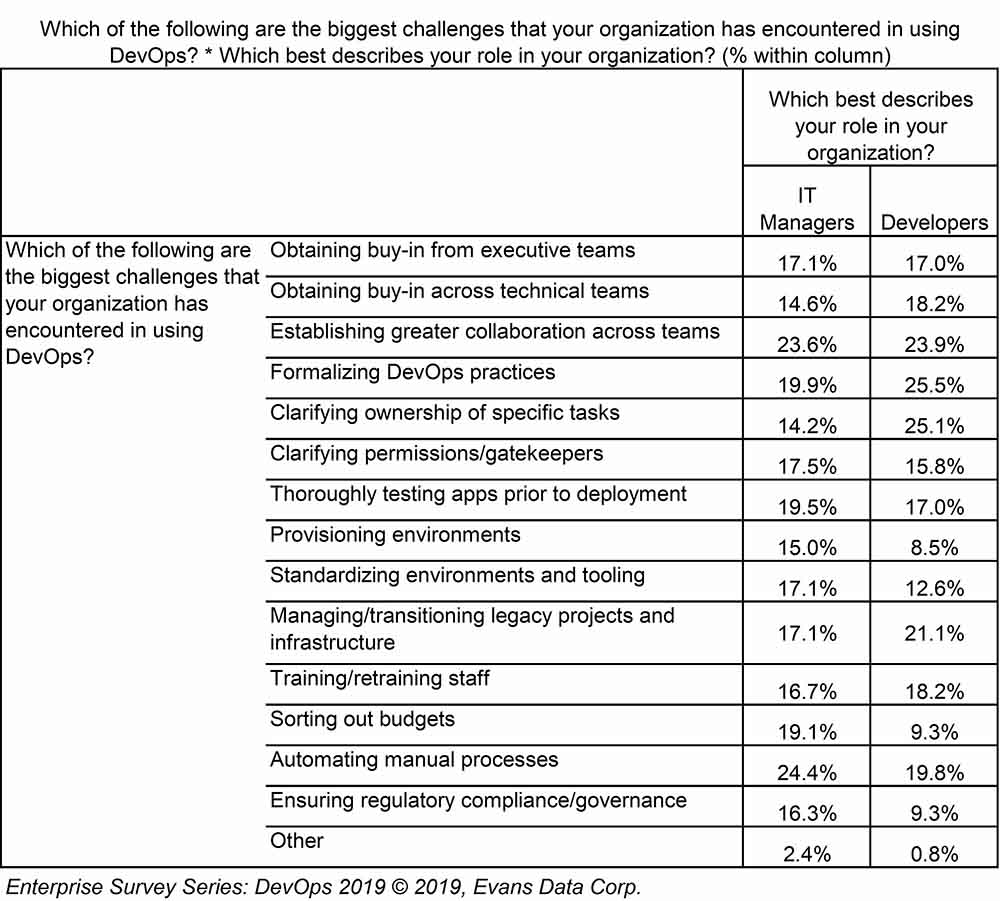Evans Data: DevOps Survey Reveals Areas of Progress & Optimism – And Where More Needs To Be Done
An Evans Data Corp. survey shows encouraging signs that 2019 may be a milestone for DevOps success. It found two key reasons for optimism -- an increasingly common vision between developers and IT, and a surge in automation tools. IDN talks with Evans Data CEO Janel Garvin about the progress – and where there’s still work to be done.
by Vance McCarthy
Tags: agile apps, automation, DevOps, Evens Data, IT operations, survey, tools,

CEO

"Automation tools are essential to ensure [developers and IT Ops] come together in collaboration rather than confrontation."
 Modern Application Development for Digital Business Success
Modern Application Development for Digital Business SuccessA new survey from Evans Data Corp. reveals encouraging signs that 2019 may be a milestone year for delivering DevOps success.
Notably, Evans founds two key reasons for DevOps optimism -- an increasingly common vision between developers and IT, and a surge in automation tools to promote better collaboration. That said, basic dis-connects between the two groups remain, Evans found, and helped identify where there is still work to be done.
[DevOps promotes and facilitates the coordination between the software developers who create apps and the operations personnel who deploy them.]
On the plus side, the Evans Data survey revealed that both developers and IT operations agreed on some major DevOps benefits -- including continuous integration and application handoff. And, both groups agree that DevOps, done properly, can provide insights into data – although in different ways, Evans Data CEO Janel Garvin told IDN. Developers pointed to the ability to use dashboards to visualize operational data, while IT managers like the ability to capture end-to-end business data, she said.
“While both the development team and operations are trying to develop, release and maintain applications in a large enterprise environment for the common good of their company, they are basically coming from different ends,” Garvin told IDN.
Interestingly, Evans Data also saw signs that a new class of DevOps tools is helping to bridge the gap. “Automation tools are essential for efficient interactions between the two groups to ensure that they come together in collaboration rather than confrontation – that along with an understanding of where each is coming from,” she added.
IDN spoke in-depth with Garvin about what DevOps trends she has seen over the years – both in culture and in technologies – and how 2019 may be a pivotal year for bring developers and IT Ops close together for DevOps success.
DevOps Gaining Thanks to Automation, More Work on Collaboration Ahead
“For maybe a dozen years DevOps existed only as a concept and then as a series of talking points – often among analysts. There was much agreement that development and operations had to work more closely, but not much happened except long conversations and some documented ‘best practices’,” Garvin said.
“DevOps was only a conceptual goal and one which was projected onto a background that portrayed development and operations as very different in ‘culture’ in order to justify the existence of DevOps as a discipline,” she said. “Here were the Hatfields and the McCoys.”
The latest Evans Data report paints a very different – more encouraging – picture, as Garvin explained it for us.
“We had an equal number of developers and IT managers [250 of each were surveyed] and we looked at the results. . . . While we certainly found some divergence, for the most part the two groups agreed with each other and on such items as workflow management, provisioning in the cloud, continuous integration and automation tools,” she said.
Garvin attributed this growing agreement between developers and IT to automation tools that help with the coordination between the two groups. “These tools are still what is enabling DevOps to grow today,” she said, adding “The tools themselves enforce the principles that development and operations agree on along with facilitating them.”
Such automation tools have become so effective, Garvin expects software and tools vendors to provide even more. “This is where we see the future going as more tools come into place and more software creation activities become orchestrated by other pieces of software.” In fact, she expects in the near future AI will help such tools drive even more and deeper coordination.
“This is an excellent place for AI implementations and we expect to see this in the not distant future,” Garvin said. Indeed, the survey also revealed that both developers and IT operations would welcome such improvements for how DevOps tools promote smart and frictionless collaboration.
Developers & IT Ops Note Biggest Challenges; Hints to a 2019 DevOps ‘Wish List’
The Evans Data survey didn’t “exactly ask for a wish list,” Garvin said. “But we did ask about the biggest challenges of DevOps use.. . [E]stablishing greater collaboration was most selected” by each group individually. That in itself is a good sign that both sides of the app pipeline are on the same page.
That said, developers and IT ops also had divergent items on the rest of their list of ‘biggest challenges,’ Evans aid. For example, developers were concerned about clarifying ownership of tasks, while IT managers were more concerned with budgets.
Evans Data shared with IDN more details on this list of 'biggest challenges' from each group in this excerpt from the survey. (see below)

Signs That More Developer / IT Ops Coordination May Lessen ‘Shadow IT’
The survey also suggests another big benefit from better DevOps coordination between developers and IT arises – a lessening in the use of hardware or software not sanctioned by IT management.
[Evans Data also calls this ‘Shadow IT,” which it describes as when “development teams and business units do their own thing (i.e. acquire equipment and software and build environments without consulting IT.”]
“[I]t’s tempting to assume... .the use of non-sanctioned tools is declining,” Garvin said, as her survey found more people have abandoned the practice (20%) than having just recently taken it up (6%). “And there may be good reasons for this.
As DevOps has become more established in the industry, and thus throughout an enterprise, there is more control from IT management in the form of best practices and automated tools . . . There is also some measure of understanding growing with developers who have been drawn into the DevOps dialogue, and now more fully grasp the issues that their operational partners encounter. These changes in perception and attitude are helping institute DevOps throughout the organization so we expect that Shadow IT will diminish – at least in large organizations.
The survey is part of Evans Data’s new Enterprise Survey series (just launched this year), which was specially created to look at enterprise development issues from both the development and operations angles. The survey includes more than 130 pages of multi-faceted data on topics such as DevOps Landscape, Provisioning, Application Handoffs, Automation Tools and Platforms, Continuous App Development, Integration and Testing, Workflow Management and more.
Evans Data will also hold its annual Developer Relations Conference on March 18-19 in San Mateo, Calif.
Related:
- InfluxData's Latest Updates Optimize Time Series Data for Better Performance, Scale and Management
- Actian Zen 16.0 Update Simplifies Delivery and Boosts Performance of Edge, IoT Apps
- Virtana Infrastructure Performance Management Adds AI-driven Capacity Planning
- e2open’s Supply Chain SaaS Updates Help Firms Reduce Operational Risks with Deeper Visibility
- Report: Endor Labs Identifies 2023 Operational, Security Risks To Open Source
All rights reserved © 2025 Enterprise Integration News, Inc.


